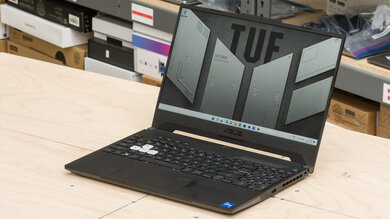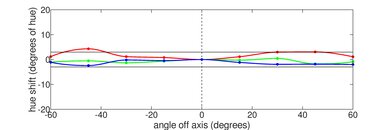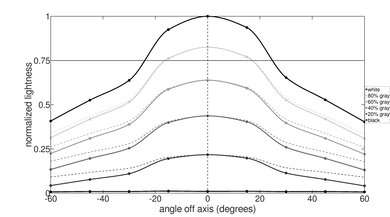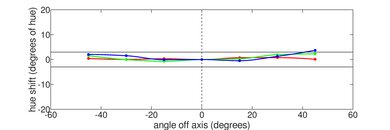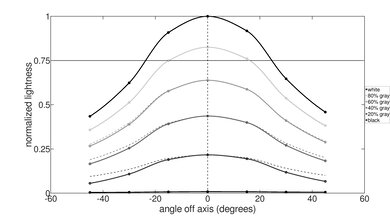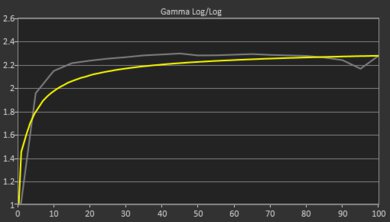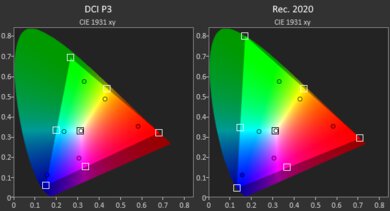The ASUS TUF Dash F15 (2022) is a 15.6-inch budget gaming laptop. It's available with an Intel Core i5-12450H or Core i7-12650H CPU and various NVIDIA RTX 30-series GPUs, from an RTX 3050 to an RTX 3070. You can configure it with up to 16GB of memory and 1TB of storage. Display options include an FHD (1920 x 1080) 144Hz, an FHD 300Hz, and a QHD (2560 x 1440) 165Hz panel. It has a full-size keyboard with a Numpad on the right, Wi-Fi 6, and a 76Wh battery.
You can see our unit's specifications and the available configuration options in the Differences Between Variants section.
Our Verdict
The ASUS TUF Dash F15 is decent for school use. It feels well-built and is fairly portable, as it isn't overly bulky or heavy. Its CPU and GPU can handle demanding tasks, making it suitable for students in more technical fields like 3D graphics. The display is large enough for split-screen multitasking, the keyboard feels spacious and tactile, and the touchpad is large and responsive. Unfortunately, the battery doesn't last a full day, so you'll have to bring the charger with you.
-
Sturdy build.
-
Fairly easy to carry around.
-
CPU and GPU can handle demanding tasks.
-
Spacious and tactile keyboard.
-
Large and responsive touchpad.
-
Short battery life.
-
Display doesn't get bright enough to combat glare.
The ASUS TUF Dash F15 is good for gaming. It's available with Intel 12th Gen. CPUs and NVIDIA discrete graphics, which are powerful enough to provide a smooth gaming experience in demanding AAA titles. It gets hot and loud under load, but thankfully, its performance doesn't drop, so you get consistent frame rates when gaming for an extended period. Its 144Hz display has a slow response time causing noticeable ghosting; however, you can get the laptop with a faster FHD 300Hz or QHD 165Hz display, which will perform better.
-
CPU and GPU can handle demanding tasks.
-
Minimal performance loss under load.
-
High-refresh display options.
-
Spacious and tactile keyboard.
-
User-replaceable memory and storage.
-
144Hz display has a slow response time and doesn't support VRR.
-
Gets hot and loud under load.
The ASUS TUF Dash F15 is okay for media consumption. It's relatively portable, as it isn't too bulky or heavy, and the battery lasts around six hours of video playback, giving you plenty of time to get through a couple of full-length movies. The speakers sound clear, which is great for speech-heavy content; however, they don't get very loud and lack bass. The FHD 144Hz display doesn't get very bright, meaning you may have some trouble with visibility in well-lit rooms, and its low contrast ratio makes blacks look gray in dim settings. It also looks slightly washed out due to its narrow color gamut, although better display options are available, like an FHD panel with full sRGB coverage and a QHD panel with full DCI P3.
-
QHD display option with full DCI P3 coverage.
-
Great battery life for video playback.
-
Speakers sound clear and natural.
-
Display doesn't get bright enough to combat glare.
-
Blacks look gray in dim settings.
-
Speakers lack bass and don't get very loud.
The ASUS TUF Dash F15 is excellent for use as a workstation. Its Intel 12th Gen CPUs and NVIDIA discrete GPUs can handle demanding tasks like video editing and 3D rendering. It loses very little performance, even when the CPU and GPU get hot, although the fans get pretty loud. You can only get up to 16GB of memory and 1TB of storage, but these components are user-replaceable, meaning you can add more later on. Also, you can get this laptop with a QHD display, which has full DCI P3 coverage, making it suitable for color-critical work. It has a spacious and tactile keyboard, and its USB-C supports Thunderbolt 4, allowing you to transfer files quickly and connect up to two 4k displays at 60Hz with a single cable.
-
CPU and GPU can handle demanding tasks.
-
QHD display option with full DCI P3 coverage.
-
Minimal performance loss under load.
-
Spacious and tactile keyboard.
-
User-replaceable memory and storage.
-
USB-C with Thunderbolt 4 support.
-
Gets hot and loud under load.
The ASUS TUF Dash F15 is good for business use. It feels very well-built, and it isn't overly bulky or heavy, so it's fairly easy to carry around. Its Intel 12th Gen. CPU can handle most productivity tasks, like text processing, spreadsheets, and presentations. You can even perform more demanding tasks like video editing, thanks to its discrete GPU. The display is large enough for multitasking, although you may have some visibility issues in well-lit rooms as it doesn't get very bright. The keyboard feels spacious and tactile but can be slightly tiring to type on for an extended period.
-
Sturdy build.
-
Fairly easy to carry around.
-
CPU and GPU can handle demanding tasks.
-
Spacious and tactile keyboard.
-
Large and responsive touchpad.
-
Short battery life.
-
Display doesn't get bright enough to combat glare.
- 7.4 School
- 7.9 Gaming
- 6.7 Multimedia
- 8.7 Workstation
- 7.8 Business
Changelog
- Updated Feb 14, 2024: Added mention of the ASUS TUF Gaming A16 Advantage Edition as an alternative with longer battery life in the Battery section.
- Updated Dec 07, 2023: Converted to Test Bench 0.8.2.
- Updated Nov 03, 2023: Converted to Test Bench 0.8.1.
- Updated Sep 12, 2023: Added mention of the Lenovo Legion Pro 5 Gen 8 16 (2023) as an NVIDIA 40-series alternative with support for Frame Generation in the GPU section.
- Updated Aug 30, 2023: We've corrected an error in the Serviceabilitysection. We previously indicated that there's only one SSD slot; there are two M.2 2280 PCIe Gen 4 SSD slots. We've adjusted the score accordingly.
Differences Between Sizes And Variants
We tested the ASUS TUF Dash F15 (model TUF517ZC-DS51-CA) with an FHD 144Hz display, an Intel Core i5-12450H CPU, an NVIDIA GeForce RTX 3050 Laptop discrete GPU, 16GB of memory, and 512GB of storage. The CPU, GPU, memory, and storage are configurable; you can see the available options in the table below. Our review applies to all models with a model number starting with 'FX517Z' or 'TUF517Z'.
| Screen |
|
|---|---|
| CPU |
|
| GPU |
|
| Memory |
|
| Storage |
|
| Color |
|
You can see our unit's label here.
Compared To Other Laptops
The ASUS TUF Dash 15 is among the best budget gaming laptops on the market. It stands out for its sturdy build, and it's one of the few budget laptops with a MUX switch.
For more options, check out our recommendations for the best gaming laptops, the best laptops, and the best budget and cheap laptops.
The ASUS TUF Dash F15 (2022) and Lenovo LOQ 15 (2023) are very similar budget gaming laptops, but the Lenovo comes out ahead. The Lenovo comes with newer and better performing AMD 7000 series CPUs and NVIDIA GeForce RTX 4000-series GPUs than the ASUS' 12th gen Intel CPU and RTX 3000-series GPU options. That said, the ASUS comes with a better range of displays, including 300Hz FHD and 165Hz QHD IPS options. The Lenovo has a 60Hz panel, but we don't suggest choosing this if you plan on gaming while using the laptop's display. Both laptops get quite loud and hot, but that's normal for this kind of laptop.
The ASUS TUF Dash F15 (2022) is better than the HP Victus 15 (2022) for most uses. The ASUS has a sturdier build, longer battery life, and a better port selection. It's also available with better displays, like an FHD 300Hz and QHD 165Hz panel, as well as higher-end GPUs, like RTX 3060 and 3070. It has better performance over time than the HP, meaning its performance doesn't drop as much in demanding workloads, but it does get hotter and louder.
The ASUS TUF Gaming A16 (2023) and the ASUS TUF Dash F15 (2022) are very similar, though the A16 comes out ahead. The A16 has higher-quality displays with better response time and color reproduction, and they support VRR to reduce screen tearing, a feature the F15 lacks. Configuration-wise, the A16 is available with AMD CPUs and GPUs, while the F15 is available with Intel CPUs and NVIDIA GPUs. The choice depends on your usage, the games you play, and the GPU features you prefer (DLSS vs FSR). The F15 is more portable for on-the-go use, but the A16's battery lasts significantly longer in light uses.
The ASUS TUF Dash F15 (2022) and the Lenovo Legion 5 Gen 6 15 (2021) are very similar overall. Although both laptops have a 15.6-inch screen, the ASUS is more portable, as it's lighter and more compact. The ASUS is available with Intel 12th Gen. CPUs, which are faster than the Lenovo laptop's AMD Ryzen 5000-series processors. The Lenovo has a wider port selection, but unlike the ASUS, it doesn't support Thunderbolt 4. It has an HDMI 2.1 port, while the ASUS' HDMI port is limited to HDMI 2.0.
The ASUS TUF Dash F15 (2022) and the Dell G15 (2022) are both 15.6-inch budget gaming laptops available with Intel 12th Gen. CPUs and NVIDIA RTX 30-series GPUs. Build-wise, the ASUS is better. It feels sturdier than the Dell, and it's more portable because it's lighter and more compact. It also has a better keyboard and touchpad, and its battery lasts longer.
The Lenovo Legion Pro 5 Gen 8 16 (2023) is better than the ASUS TUF Dash F15 (2022). The Lenovo can push higher frame rates and handle more demanding games, as it's available with faster AMD 7000 CPUs and NVIDIA 40-series GPUs. You also get Frame Generation on the Lenovo, an NVIDIA 40-series GPU feature that can dramatically boost performance in supported games. The Lenovo has a faster 240Hz QHD+ display option, and its displays support VRR to reduce screen tearing. On the other hand, the ASUS feels sturdier and is more portable, and it supports Thunderbolt 4. Its battery lasts slightly longer but doesn't charge as quickly as the Lenovo.
The ASUS TUF Dash F15 (2022) is better than the Lenovo IdeaPad Gaming 3 (2021) for most uses. The ASUS is slightly more portable, as it's lighter and more compact, and its build feels sturdier. It has a larger, more responsive touchpad, better-sounding speakers, and a wider port selection. The ASUS' Intel 12th Gen. CPU performs better than the Lenovo laptop's AMD Ryzen 5000-series. Also, you can get the ASUS with a higher-end NVIDIA GeForce RTX 3070 GPU.
The ASUS TUF Dash F15 (2022) and the HP Victus 16 (2021) are very similar, although the ASUS is slightly better. It's more portable than the HP because it's a smaller laptop, and it feels more sturdily built. Also, it's available with faster Intel 12th Gen. CPUs and a higher-end NVIDIA GeForce RTX 3070 GPU.
Test Results
The ASUS TUF Dash F15 2022 has a gamer aesthetic with design elements that convey a 'tough' build, but because it's all-black with only a few white-color keys, it doesn't feel overdone and won't stick out too much in a professional work environment. There are air vents on both sides of the laptop and the back. On the bottom, you can find the speakers near the front and more air vents near the back.
The build quality is excellent. The construction is a mix of metal and plastic, and it feels very sturdy, exhibiting only a small amount of flex in the display and none on the keyboard deck. The whole device feels hefty, with evenly distributed weight. The finish doesn't scratch easily, but like most dark-color finishes, it's a fingerprint magnet. The feet are strong and adhere firmly to the bottom.
The hinge is outstanding. It feels relatively smooth when opening and closing the laptop, and it's very stable. There's only a tiny amount of screen wobble when typing aggressively. The hinge has a lot of resistance, but you can still open the laptop with one hand. The resistance just makes fine adjustments more challenging, so you may have trouble getting it to the exact angle you want.
The ASUS TUF Dash 15 isn't overly bulky or heavy, so it's relatively easy to carry around. Its power adapter is compact and lightweight.
The serviceability is good. Accessing the internals is easy; you only need to remove 12 Philips screws and pry open the bottom panel. The plastic clips holding the panel feel sturdy and clip back into place without any issue. The two M.2 SSD slots support M.2 2280 PCIe Gen 4 NVMe SSDs but don't support SATA drives. The wireless adapter is likely user-replaceable due to its connector, but it's very hard to access. As such, we consider it non-replaceable. You can see the service manual here.
The ASUS TUF Dash 15 is available with the following displays:
- 15.6" IPS 1920 x 1080 144Hz
- 15.6" IPS 1920 x 1080 300Hz
- 15.6" IPS 2560 x 1440 165Hz
At 15.6 inches, the FHD (1920 x 1080) displays look decently sharp. You can make out individual pixels if you're very close to the screen, but it isn't a problem at normal viewing distances. If you want the best visuals, the QHD (2560 x 1440) panel is the sharpest, with a pixel density of 188 PPI. However, you need to pair it with an NVIDIA GeForce RTX 3070 GPU, as the other GPUs will struggle to reach high frame rates at 1440p.
As mentioned in the screen specs section above, you can get the ASUS TUF Dash 15 with an FHD 144Hz, an FHD 300Hz, or a QHD 165Hz display. The FHD 144Hz has a rather slow response time, causing noticeable ghosting behind fast-moving objects. The FHD 300Hz and QHD 165Hz panels likely have a faster response time, but again, you'll have to pair the QHD panel with an NVIDIA GeForce RTX 3070 to get the most out of it.
The ASUS TUF Dash 15's 1080p 144Hz panel has a good contrast ratio for an IPS panel. However, it's still relatively low compared to other display technologies like VA and OLED. This level of contrast results in blacks that look gray in dim settings. The other panels will likely perform similarly.
The FHD 144Hz display doesn't get very bright, meaning you may have visibility issues in well-lit or sunny environments. It gets very dim at the lowest brightness setting, though, which is great for dark room viewing as it causes less eye strain. The other panels will likely have the same brightness.
The reflection handling is great. The display's matte finish does a good job of reducing the intensity of bright reflections. The reflections are visible when viewing light-color content with the screen at maximum brightness, but it's not too bad. It's mainly dark-color content that you'll have the most trouble with because the matte coating causes a halo effect around bright reflections, resulting in a hazy look in other areas of the screen.
The ASUS TUF Dash has a mediocre horizontal viewing angle. The image dims and washes out quickly as you move to the side. You have to be more or less directly in front of the screen to see an accurate image.
The vertical viewing angle is okay. It's a little better than the horizontal viewing angle, but the image still dims and washes out fairly quickly when viewing from above and below.
The display's accuracy is great out of the box. The white balance is outstanding, and the color temperature is very close to the standard 6500K target. Most of the color inaccuracies are minor; it's mainly the primary colors that are visibly off because the display has a narrow color gamut and can't produce those colors. The gamma is slightly too high in most scenes, making the image darker than it should be.
The FHD 144Hz display's color gamut is bad. It doesn't even have full sRGB coverage, making most content look slightly washed out. It also has bad coverage of wider color spaces like Adobe RGB and DCI P3, so it isn't suitable for photo editing or viewing and producing HDR content. The manufacturer advertises the FHD 300Hz display to have full sRGB coverage and the QHD 165Hz display to have full DCI P3.
The ASUS TUF Dash has a great keyboard. The layout feels spacious and is easy to get used to, and the keycaps feel high-quality. The keys are stable, have a lot of travel, and provide satisfying tactile feedback. However, they require a fair amount of force to actuate and might cause some fatigue over time. Typing noise is very low and isn't bothersome in quiet settings. You can adjust between three backlight brightness levels or turn it off completely.
The touchpad is great. It's large, and it feels smooth even though it's plastic. It tracks all movements and gestures well, even around the edges, and there are no issues with palm rejection or actions like dragging and dropping. You can click almost anywhere on the touchpad except at the very top, and the click mechanism feels satisfying.
The ASUS TUF Dash F15 2022 has good speakers. They sound relatively clear and natural, but they have very little bass and don't get very loud.
The ASUS TUF Dash F15 2022's webcam is okay. The image is well-exposed, and the colors look good. However, some smaller details and textures look blurry, and there's also some noise in darker areas. Voices sound loud and clear but slightly boomy and unnatural over the microphone.
The ASUS TUF Dash F15 has a great port selection. The two USB-As support USB 3.2 Gen. 1 data transfer speed (up to 5 Gbps). The USB-C closest to the front of the device supports USB 3.2 Gen. 2 data transfer speed (up to 10Gbps), DisplayPort Alt Mode, and Power Delivery. Power Delivery allows for fast charging of mobile devices. The other USB-C supports Thunderbolt 4 (up to 40Gbps data transfer speed and video output to two 4k displays at 60Hz).
The wireless adapter is an Intel Wi-Fi AX201.
The ASUS TUF Dash 15 is available with the following CPUs:
- Intel Core i5-12450H (8 cores/12 threads, up to 4.4GHz, 12MB cache)
- Intel Core i7-12650H (10 cores/16 threads, up to 4.7GHz, 24MB cache)
Both CPUs are high-performance mobile processors typically found in gaming laptops and mobile workstations, and both have a hybrid design with a mix of performance and efficiency cores. The Core i5-12450H has four performance and four efficiency cores, while the Core i7-12650H has six performance and four efficiency cores. Only the performance cores have Hyper-Threading—the ability to process multiple threads simultaneously—which is why the number of cores and threads seems odd. They can both handle demanding tasks like gaming, as well as production workloads like video editing and 3D animation. The Core i7-12650H is faster, although the difference is minimal in GPU-limited games where CPU utilization is relatively low.
The ASUS TUF Dash 15 is available with the following discrete GPUs:
- NVIDIA GeForce RTX 3050 Laptop 4GB GDDR6 (75W TGP with Dynamic Boost)
- NVIDIA GeForce RTX 3050 Ti Laptop 4GB GDDR6 (75W TGP with Dynamic Boost)
- NVIDIA GeForce RTX 3060 Laptop 6GB GDDR6 (105W TGP with Dynamic Boost)
- NVIDIA GeForce RTX 3070 Laptop 8GB GDDR6 (105W TGP with Dynamic Boost)
All four GPUs belong to NVIDIA's RTX 30-series and come with features like ray-tracing and DLSS. The RTX 3050 and 3050 Ti are very close in performance and are best suited for 1080p gaming at medium or low settings. The 3050 Ti is only about 10% faster than the 3050 on average. The RTX 3060 is a good step up from the RTX 3050, giving you higher frame rates at 1080p with medium or high settings. The RTX 3070 is the fastest and is best suited for the QHD 165Hz panel. This laptop has a MUX (multiplexer) switch to allow the GPU to send information directly to the display without going through the integrated GPU, meaning you'll see dramatically better performance than on laptops that lack this feature. The performance difference can be anywhere from 10% to 25%, or more in some cases. If you want an NVIDIA 40-series laptop with Frame Generation support, check out the Lenovo Legion Pro 5 Gen 8 16 (2023).
You can configure this laptop with 8GB or 16GB of memory. Both configurations are in single-channel mode, which can reduce performance in some games. If you want to get the most performance out of the laptop, it's best to add a second memory module so that it runs in dual-channel mode.
You can configure the laptop with 512GB or 1TB of storage. The SSD is user-replaceable. There are two SSD slots; both support M.2 2280 PCIe Gen 4 x4 SSDs.
The ASUS TUF Dash 15 2022 has an overall outstanding score in the Geekbench 5 benchmarks. The numbers are a little low compared to laptops with a similar CPU because this laptop's memory is in single-channel mode. Adding a second memory module to run in dual-channel mode will improve performance. The Intel Core i7-12650H is a good deal faster than the Core i5-12450H, so while both CPUs can handle demanding tasks, the Core i7 will provide a smoother experience overall. For GPU computing tasks, the NVIDIA GeForce RTX 3050 performs very well. However, if you perform VRAM-heavy tasks, it's best to go with the RTX 3060 or 3070.
The Intel Core i5-12450H in the ASUS TUF Dash F15 performs exceptionally well in Cinebench R23, making it suitable for rendering and other CPU-heavy workloads. The Intel Core i7-12650H will perform better due to its increased core count and faster clock speeds.
The ASUS TUF Dash F15 2022's 3D rendering performance in Blender is excellent. The Intel Core i5-12450H can complete renders relatively quickly; however, there's no need to render with the CPU because the dedicated GPU can do it significantly faster, especially when using NVIDIA Optix hardware acceleration. The other GPUs will perform better, with the RTX 3070 being the fastest.
The NVIDIA GeForce RTX 3050 Laptop GPU in the ASUS TUF Dash 15 scores well in the Basemark GPU benchmark. The RTX 3050 is mainly a 1080p 60 fps gaming GPU. It can push over 60 fps in graphically demanding titles, but you'll have to play at medium or low settings. The RTX 3050 Ti is about 10% faster, which means it can push over 60 fps with fewer tweaks in the settings. The RTX 3060 will get you closer to 80 or 90 fps with high settings in demanding games. The RTX 3070 is the fastest GPU and best suited for 1440p gaming.
The 512GB PCIe Gen 3 NVMe SSD performs exceptionally well. Its fast read and write speeds allow the system to boot up, launch apps, and transfer files quickly. The 1TB storage drive will likely be slightly faster, as larger SSDs tend to perform better.
The ASUS TUF Dash 15 has mediocre battery life. Even with a light workload, you'll have to plug it in to get through a typical 8-hour work or school day. The battery life for video playback is pretty good, though; enough time for a couple of full-length movies. The battery life while gaming is short but still excellent for a gaming laptop with a high-refresh display, an H-series CPU, and a dedicated GPU. Models with an FHD 300Hz or QHD 165Hz display will have shorter battery life, and the same goes for models with an NVIDIA GeForce RTX 3060 or 3070. If you plan to use the laptop for productivity tasks and want a model with longer battery life in light uses, check out the ASUS TUF Gaming A16 Advantage Edition (2023).
The ASUS TUF Dash 15 2022's performance in Borderlands 3 is acceptable. The NVIDIA GeForce RTX 3050 can push comfortably over 60 fps with only a few tweaks in the settings. There are some noticeable stutters, as the frame rate sometimes drops drastically, but they don't happen all that often. Every CPU and GPU configuration can run this game smoothly, provided you lower some settings, especially with an RTX 3050 or 3050 Ti.
Civilization VI runs well. This game isn't particularly GPU-intensive, so every GPU can push high frame rates and provide smooth gameplay. The turn time is decent with an Intel Core i5-12450H; upgrading to the Core i7-12650H will only improve it slightly.
The ASUS TUF Dash's performance in CS:GO is excellent. Every configuration can run this game smoothly, though upgrading to the Core i7-12650H or a faster GPU will result in higher frame rates. You can even run this game at 1440p without any issues.
The ASUS TUF Dash 15 with an Intel Core i5-12450H and an NVIDIA GeForce RTX 3050 can push over 60 fps at high settings in Shadow of the Tomb Raider; however, the game stutters a lot at regular intervals due to memory bandwidth limitations, as the 16GB is running in single-channel mode. Adding a second stick of RAM to run in dual-channel mode will result in significantly smoother gameplay. Every configuration can run this game and other similarly-demanding titles smoothly; you just have to upgrade the RAM.
The ASUS TUF Dash 15 has mediocre thermal and noise handling. The keyboard is only mildly warm when idle, and the fans are barely audible. Under load, the keyboard deck gets hot; however, the hot spot is near the top, away from where most people rest their hands. Although the fans get a little loud, the noise is mostly the sound of heavy airflow, so it isn't particularly annoying. That said, this is only in the default Performance mode. They get louder in the Turbo mode, up to 53 dBA.
The ASUS TUF Dash's performance over time is outstanding. Neither the CPU nor the GPU gets particularly hot under load. The CPU throttles, but the performance loss is very minimal.
The ASUS TUF Dash 15 has a few pre-installed applications, including:
- C-Media Audio Control Panel: Lets you change the sound profile and tweak the EQ.
- MyASUS: Contains system and warranty information.
- Armory Crate: Lets you monitor the system status and control the fan and power profiles.
- AI Noise Cancelation: Suppresses background noise when using the microphone.
Comments
ASUS TUF Dash F15 (2022): Main Discussion
Let us know why you want us to review the product here, or encourage others to vote for this product.
This product has been merged with ASUS TUF Dash 15.6" 144Hz FHD IPS Gaming Laptop (I. Follow the discussion here.


